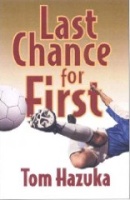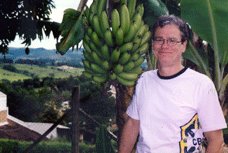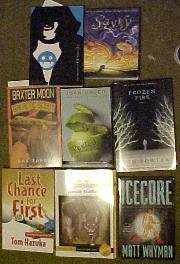Another
Column at MyShelf.Com
|
| Babe To Teens, Past |
| Tell us your story...just for the fun of it. What did you do during summer vacation? Send me an email with your vacation story of 500 words or less, and I will include it in the next issue of Babes to Teens. I'm sure that you all had a great time this summer. Tell us about it! Just send it by email to bevbooks@aol.com, and put "Summer Story" in the subject line. I can hardly wait to read about it.
About Tom Hazuka: LAST CHANCE FOR FIRST is Tom Hazuka's first crossover novel - for adults and young adults - he revisits his love for soccer in this exciting, action packed story. 
Tom Hazuka played varsity soccer in high school and college, spent his junior year of college in Switzerland, and after graduation, he was in Chile with the Peace Corps for two years. Tom does still love soccer, but his first teen novel is much more than a soccer story. I asked Tom about his writing career, and here is what he had to say.
Click HERE to read Beverly's review of Last Chance for First on Myshelf.com.
Bev: Tom, could you tell us about yourself? A mini-biography?
When I returned to the U.S., I moved across the country for a master's degree at the University of California at Davis, then a Ph.D. at the University of Utah. Currently I'm back in my home state, where I'm a professor at Central Connecticut State University. I teach classes in literature and fiction writing. After many years of playing team sports (we had some excellent soccer, basketball and softball intramural teams at U.C. Davis and the U of Utah!), I hurt my back and these days just swim, bike and play tennis, along with light weightlifting. Bev: What did you like to read when you were a kid? Tom: When I was a kid about all I did was play sports and games and read. I read constantly. I never had a systematic plan; I read whatever crossed my path. I used to love to go the library and browse, leaving with a stack of books that for whatever reason caught my attention. Once in a while I'd look for a specific book, but rarely. I sure don't recall anything like the recent Harry Potter craze, where a book became a fad and it was the cool thing to read it because everyone else was. Now, of course, I hope that Last Chance for First becomes the next fad! Bev: Who are your favorite authors now? Tom: I always have trouble with this question because there are so many fine writers. How about if I list my five favorite books? Here goes (in no particular order): Adventures of Huckleberry
Finn, Mark Twain I'm also a big fan of Philip Roth, and I love the short stories of Alice Munro, Raymond Carver, Anton Chekhov, William Trevor and George Saunders. I'm leaving lots of people out, but that's a start at least. Bev: How long have you been writing? What was your first publication? Please tell us about your journey as a writer. Tom: I never wrote much until Mr. Truxes'
creative writing class my senior year of high
school. During college I mainly wrote academic
papers, but in the Peace Corps I began writing
poems and songs (I've since written over 150
songs). My first publication, a poem called
Dwarf of the Diamond, came out in Ideals
magazine while I was in the Peace Corps. I
was paid $15 and thought publishing was easy
- until everything I sent out for the next five
years was rejected. Hmm, not so easy after
all. My first fiction publication was a short
story, "Falling Out," in Sun Dog: The Southeast
Review, that appeared six years after I
returned from the Peace Corps. My first novel,
Even books that seem like they're sure to be popular sometimes fall through the cracks. When the athletics director at my university, C.J. Jones, and I wrote A Method to March Madness: An Insider's Look at the Final Four, we were sure that it would be a big seller. C.J. has attended every Final Four basketball tournament except one since 1973, and the book is full of fascinating information and stories from him and well-known coaches and players. But the book never got the publicity we'd hoped for. If anyone wants signed copies at a big discount, get in touch with C.J. or me! Bev: Checking with Amazon.com, I see that you have two adult fiction books on the market, but this is your first Young Adult book. In retrospect, which do you prefer to write...for adults or for teens, and why? Tom: I sincerely don't have a preference between writing for an adult or a young adult audience. For me, writing a novel is writing a novel, and I would hope that readers of any age would like all of my books. The only difference with Last Chance for First was the challenge of writing convincingly in the voice of someone sixteen years old, when I am quite a bit older than that. But inhabiting other characters is the biggest part of being a fiction writer. It can be the hardest part as well, but is often the most interesting. For example, my favorite of all my short stories, "All She Wrote" (published in Quarterly West), is written in a woman's voice. In fact, several of my best short stories are from a woman's point of view. Writing from the perspective of the opposite gender was possibly a greater challenge than pretending to be sixteen again. After all, I've been sixteen, but I've never been female. Bev: Was any other author an inspiration or influence for you to write a book for teens? Tom: No other author inspired me to write Last Chance for First. I had been thinking for a while that I wanted to write a soccer novel, and it just seemed natural to deal with high school soccer. First, that's the level of soccer I know most about, and the level where I had the most success. Second, fiction depends on conflict, and high school is a time of significant conflict for everyone. Every kid of that age is trying to find out who she or he is. I know I was. So I was confident that plenty of compelling issues would arise as I explored this situation. And they did. Bev: Tell us about developing the characters, especially Robby and Pet. Is there any of you in the character Robby? Tom: There are elements of me in Robby, the narrator, though he's mostly invented. He's a soccer star, for example, while I was only a good but not great player. He has an older brother; I'm the oldest of four boys in my family. By the way, Robby originally had an older sister as well, but I cut her out of the final draft. Her character didn't add anything to the story that couldn't be shown through Robby's brother Paul, so out she went. Besides, at that point I was hard at work condensing the novel, tightening it as much as possible. Believe it or not, in a month I cut 30,000 words from the novel before it went to press. When Nancy Hammerslough, my editor at Brown Barn Books, said I should trim Last Chance for First from 111,000 words to 80,000, I worried that it would be impossible. But in that month I got the novel under 80,000 words, and it's much better as a result. Bev: I know that you played soccer in high school and college and are still a great fan. Do you outline and minutely plan your story, or just write and let the plot develop itself? Tom: I never plan or outline a book. For me that would just create writer's block. How can I outline what I don't know yet? Every day my writing is a process of discovery. I'm rarely sure what the characters are going to do in the next sentence, let alone the next chapter. Whether I'm working on a novel or the shortest flash fiction story, I never know the ending when I start. The great joy in fiction is discovering this as I go along, what I call writing my way out of a story. Bev: Do you have any future plans for Robby and gang? Tom: At this point I have no plans for another book about Robby, Pet and Jim. Last Chance for First is actually a semi-sequel to my first novel, The Road to the Island. It takes place in Newfield ten years later, and some of the same characters appear. For example, Jim is the son of the narrator of The Road to the Island, and Jim's mom and stepdad are major characters in the earlier book. But Robby and Jim were only six years old back then, so aren't aware of a lot that went on. I think that readers of The Road to the Island will get a kick out of the references and connections in Last Chance for First, and vice versa, especially when in some cases they know more than Robby the narrator does. Bev: Do you have any plans to do an anthology of your short stories? Tom: I definitely have plans to publish a collection of my short stories. In fact, I have two separate book manuscripts of them. So far, though, publishers have said nice things about the collections but worried they wouldn't be commercial enough. Evidently few short story collections sell well, at least those by a single author. Anthologies with stories from many writers don't seem to have that problem. Flash Fiction, an anthology of very short stories (750 words or less) that I edited with James and Denise Thomas, has sold steadily over the years. You Have Time for This, a collection of even shorter stories (500 words maximum) that I recently edited with Mark Budman, is also finding an audience. So we'll see. I've learned that perseverance is important for a writer, as important as developing a thick skin to deal with rejection. Bev: Are you working on any major projects now? Tom: I'm currently working on a memoir of my time in the Peace Corps, and what it was like to return to Chile after many years. I've written 215 pages so far and hope to be finished by spring of 2009. But as I mentioned earlier, I don't know how it ends yet. That seems appropriate, actually, when talking about your life. Bev: Do you have any other thoughts you would like to share with us? Tom: Thanks very much for inviting me to do this interview. I enjoyed it. If readers would like to get in touch with me about any of my books, my email address is in the "About the Author" section of Last Chance for First. Happy reading.
Contest: Eight great books
Icecore by
Matt Whyman
|
| 2008 Past Columns
|
||||||||||||
© MyShelf.Com. All Rights Reserved.



 To enter, send an
To enter, send an